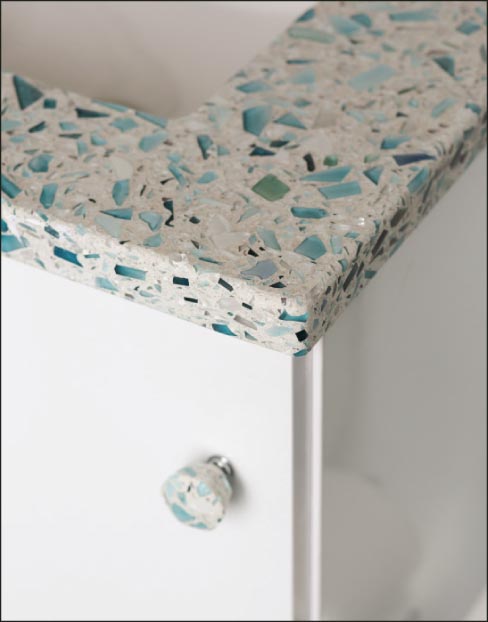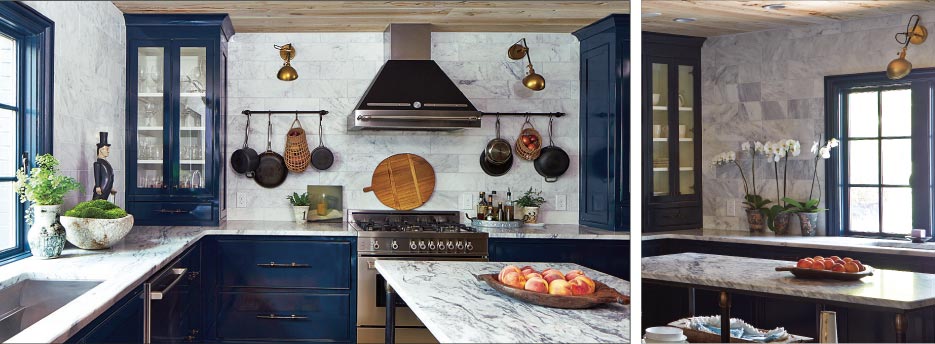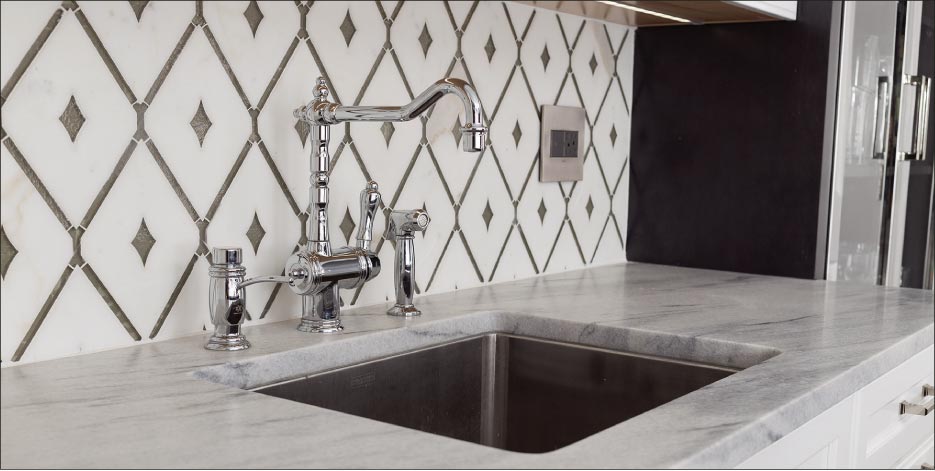Quartz Vs. Marble
Are Look and Performance Mutually Exclusive?
Steven Schrenk
Polycor
Photos: Ryan Struck Photography
 |
|
Floating Vetrazzo Blue Seapearl Finish Vanity and Hardware by Toni Sabatino Design |
If your client’s red wine and pasta Sundays are pushing your design from natural stone to quartz, it may be a myth about durability driving your design rather than your eye (or your client’s cooking).
The differences between marble and quartz, for instance, are varied and complex, with each material excelling in different applications and under different conditions. The choice between engineered or natural surfaces is more than an issue of performance; it’s still about the look.
This article will take a look at quartz versus marble, offer some comparisons, plus give you some examples of how the two materials play best together.
Organic Vs. Uniform
Quartz is a good choice when designs call for consistency and uniformity, like in kitchens with ultra modern lacquered cabinetry. The unbroken surface of a high polished gray or white quartz has a sleek, formal appearance. It’s also available in a wide variety of shades.
It’s also a good foil for a marble or granite island with an active vein pattern. Or as a pairing for a unique, handcrafted material like Vetrazzo’s crushed glass slabs. Here the uniformity of perimeter counters allows the bar top to stand out as a feature.
In designs where you’re looking for an organic quality, the natural variations of veining in an American marble like Pearl Grey work to support a natural feel. Like the figuring in a live edge wood slab, the vein pattern in a slab of US marble, for instance, is completely unique to that piece. If that’s your kitchen island, there will never be another one like it.
 |
|
Traditional kitchen designs in Pearl Grey American marble from the Polycor Quarry in Tate, Georgia. |
Some quartz manufacturers like Ceasarstone have developed countertops to mimic the veining (though not the depth) of natural marble.
Whether they achieve the effect is up to the viewer. Obviously for us as quarrier of natural stone, we find the luxury of a material is its authentic, naturally occurring characteristics. Because marble is made of minerals it has an internal crystal structure that gives the surface depth and dimension — you can literally look into the stone and see its layers. (Given the choice between the stone and a picture of stone, I’d take the real thing.)
This especially appeals to clients who are art collectors or who want to curate a home with bespoke fixtures and furnishings. April Graves of Aria Stone Gallery in Texas told me that her clients are now designing entire living spaces around one showpiece slab of natural stone, and even hanging it as art. You could do the same with quartz, but the difference is like walking into a gallery to choose an artist’s unique piece or buying a screen print at TJ Maxx. With quartz surfaces they are printed each one exactly like the one before.
Texture, of course, is a consideration with specifying a countertop material. Both honed and polished finishes can be applied to marble and quartz (though the usually stain and scratch resistant quartz is prone to scratch with a honed finish). Where natural look and feel are a priority, marble tends to win out for its touchability – a honed marble countertop feels and looks like a wind-worn rock.
 |
|
This contemporary New Jersey kitchen showcases Cherokee White American marble, from the Polycor quarry in Tate, Georgia. |
Durability of Marble Countertops Compared to Quartz Countertops
The durability of marble versus quartz is probably one of the most misunderstood subjects to those inside and outside the trade.
Marble is luxurious, but requires maintenance. True. But does its need for maintenance mean it’s fragile or impractical? Actually, no.
Back to our illustration of the Sunday supper. That red wine and tomato sauce (and lemon juice too) can stain marble are known facts. However, there are some marbles that stand up better than others to acidic agents. For this post I’ll be referring specifically to US marble which has a higher resistance to stains than Italian or Indian marble.
Here’s why:
Every material has its own absorption rate. It’s a good indicator of how quickly something will penetrate the surface.
The lower the absorption rate, the more time to wipe up spills.
Granite for instance has a very low absorption rate, which makes a good choice for about any surface. Quartz also has a low absorption rate because it’s engineered surface is made with resin. Marble is known for staining because unsealed many varieties can absorb liquids more quickly. American marbles like Pearl Grey and White Cherokee are the exception though. Their crystalline make-up gives them an absorption rate of just .09, and that’s before a sealer. Quartz is a manufactured surface and therefore doesn’t need a sealer.
And quartz is durable. True. But does durable mean indestructible? Again, no.
There are two things that can damage quartz irreparably—direct sunlight and heat. Any exposure to direct sunlight and high UV rays will warp and discolor quartz, causing it to yellow. Similarly a very hot pot placed on its surface can scorch it.
And there’s no cleaner for that.
Quartz is harder than marble, and it’s well known that its surface is resistant to scratching. Lesser known is its lack of dimensional strength which can place limitations on design. For instance, radius corners in quartz surfaces (anywhere there is a directional change in the stone, like sinks and inside corners) must be rounded to maintain their integrity. When they come together, if they are left square and straight, there are weak portions that can crack and break. If your design calls for a square sink it can void the warranty on the quartz. Marble can be left square and not have weak spots. Both marble and quartz can chip on the edges.
 |
Ultra-thin slabs for wall and floor installs
Marble and quartz both can be produced in ultra-thin slabs for cabinet facing and modern-look countertops, full slab showers and backsplashes. Currently Polycor is the only company producing ultra-thin natural stone slabs in 1 cm thickness that also have a reinforced back which gives them 10x flexural strength.
When appropriately specified, both US marble and engineered quartz can be beautiful, durable materials for kitchens and baths. Knowing their strengths and limitations can help you tailor your design to your client’s lifestyle without restricting your design based on myths of material choices.
Now, instead of asking, “What are you cooking and how often do you clean?” you can ask, “What’s the look you want to achieve?”